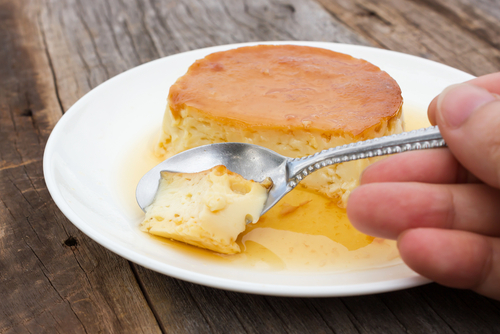Short answer
Custard can be bad for you if you eat it frequently, due to the potentially high amount of fat and added sugars. However, if enjoyed infrequently, custard is fine for most. Be aware that store-bought varieties may include harmful additives.
Recommended Alternative
More harmful than beneficial. Side effects are common, especially when consumed/done excessively. Moderation is very important.
View Full Grading System
Category 'A'
Very healthy and numerous health benefits. Side effects are rare. Things rated an 'A+' are typically necessary for survival (for example, water).
Very healthy and numerous health benefits. A few harmful qualities may be associated, but only under certain circumstances such as an allergic reaction.
Very healthy and numerous health benefits. Harmful qualities may be associated, but aren't usually serious.
It is important to note that even the best things in life can become bad in immoderate amounts. So, although something may be rated an 'A+', overconsumption/overdoing can bring unwanted effects.
Category 'B'
Very beneficial to your health. Things rated a 'B+' may have a few harmful qualities to pay attention to.
Overall beneficial to your health. Things rated a 'B' may have some harmful qualities to pay attention to.
More beneficial to your health than not. However, harmful qualities are most likely associated and shouldn't be overlooked.
The main difference between category 'A' and category 'B' is the harmful qualities typically present in 'B' items. Serious side effects are usually uncommon, but are still possible and should be taken note of.
Category 'C'
Both beneficial and harmful qualities associated. Things rated a 'C+' are typically a bit more on the beneficial side. Still, moderation is important.
A fairly even ratio of beneficial and harmful qualities. Moderation is important. Very general topics that can lean towards both sides of the spectrum will be placed here as well. Rice, for example, can be good or bad depending on the type.
More harmful than beneficial. Side effects are common, especially when consumed/done excessively. Moderation is very important.
Category 'C' usually denotes to both good and bad qualities. When it comes to this category, it is important to keep this word in mind: moderation.
Category 'D'
Harmful to your health. Although benefits may be associated, the bad most likely outweighs the good. Moderation is very important.
Harmful to your health. A few benefits may be associated, but the bad outweighs the good. Moderation is extremely important.
Harmful to your health. Very few, if any, benefits are present. Things in this category should be avoided as much as possible.
Category 'D' is typically for things that are more harmful than beneficial. While consuming/doing something unhealthy once in a blue moon shouldn't hurt, we definitely recommend eliminating 'D' items as a regular part of your routine/diet.
Category 'F'
Category 'F' is for things that fail to bring anything beneficial to the table, and are very harmful to your health. We recommend completely avoiding anything in this category. Long-term side effects of 'F' items are usually very serious.
Category 'N'
'N' stands for neutral. Things placed into this category are generally (a) neither good nor bad for you, or (b) lack the necessary evidence to reach any conclusions.
Long answer
How healthy custard is depends entirely on how it is made. Custard can be made in a number of ways - powdered, UHT, baked, stirred, etc. The most common custards, however, are creme anglaise and creme patisserie. Homemade custard is made primarily with milk or cream and egg yolk, while store-bought custard may contain any of the following: milk solids, starch, sugar, thickener, flavorings, vegetable gum, and colors.
As with many other types of food, the tastier the custard, chances are the worse it is for your health. The rich, creamy taste found in full fat custard also carries with it about 6% the daily recommended value for fat per serving, while regular custard will give 1-3% and low-fat custard carrying about 0-1% of the daily value of fat.
As custard is made using milk or milk products, it does contain some lactose, which is of concern to people who are lactose intolerant. The amount of calories vary widely, with low-fat varieties holding around 85 per serving, while custards with the full amount of fat having over 120 calories per serving.
Custard is not completely bereft of benefits, however. It does provide a good amount of calcium and offers a substantial dose of B-vitamins, especially vitamin B12. Naturally, homemade custard that does not have the extra additives is much better for you than the store-bought varieties.
Overall, custard is not the best thing you can put in your body, but if enjoyed every now and then, it shouldn't cause any problems to your health. Regular consumption of custard could lead to weight gain and an increased risk of heart problems, though.
Possible short-term side effects
- allergic reaction
-
blood sugar spike
Possible long-term side effects
- weight gain
-
heart disease
-
diabetes
-
cancer
Ingredients to be aware of
Benefits
- good source of calcium
-
good source of vitamin b12
Healthier alternatives
- custard made from home with natural ingredients
Our Wellness Pick
(what is this?)
Biona White Rice Pudding
- Organic certified
- Preservative-free
- Non-GMO
- Vegan-friendly
- Gluten-free option
Learn More!
Please turn your Ad Blocker off to see this content. Thank you!
Thank you for your feedback!
Written by Jeff Volling
Published on: 01-04-2016
Last updated: 12-15-2023
Thank you for your feedback!
Written by Jeff Volling
Published on: 01-04-2016
Last updated: 12-15-2023

 Approved by
Approved by 















